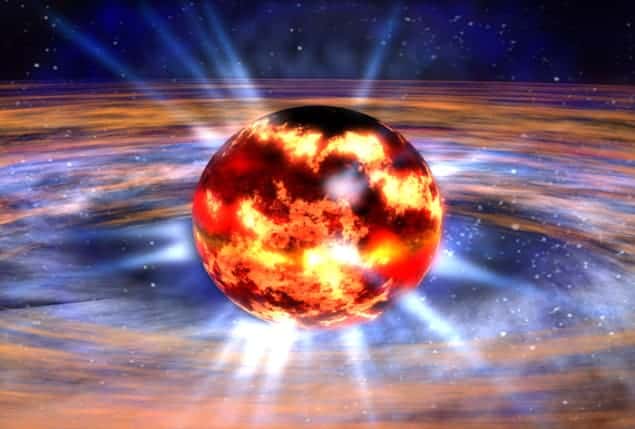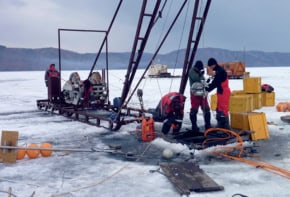
Neutron stars could share some unlikely similarities with metallic alloys here on Earth. That’s the conclusion of two physicists in Scandinavia, who have carried out calculations that reveal that the nuclei and neutrons in the outer crust of these stars play a similar role to the different metals in an alloy. The finding could provide insights into some observable properties of neutron stars, including gamma-ray bursts, rotational glitches and gravitational waves.
Neutron stars are dense spheres with a radius of just 11–12 km in which the gravitational pressure is so strong that the electrons have merged with protons to form a structure that is almost entirely composed of neutrons. Neutron stars are believed to have an outer crust about 1–2 km thick that behaves rather differently from the rest of the star. The crust is thought to contain protons that clump together with neutrons to form what are essentially neutron-rich nuclei, with the electrons forming a residual background charge.
As for the neutrons not bound to nuclei, these can move freely about the crust. The conventional view is that these free neutrons have little effect on the crust, the result being that the nuclei arrange themselves into the body-centred cubic (BCC) crystal structure favoured by many metals. However, Dmitry Kobyakov of Umeå University in Sweden and Chris Pethick of the Niels Bohr Institute in Denmark and NORDITA in Stockholm now argue that the free neutrons do play an important role in the crust.
Attractively drippy
The researchers focused on crusts with a density above which some neutrons are no longer bound in nuclei but “drip” out – the density at this threshold being about one thousandth that of a nucleus. According to their calculations, the free neutrons lead to an attractive interaction between the nuclei and that – under certain circumstances – makes the crystal unstable to distortions of the BCC lattice. This could in turn trigger a structural phase transition from BCC to a cubic lattice with two atoms per unit cell. This can be envisioned as the movement of the “body-centred” atom in the BCC unit cell towards the centre of a face of the cubic cell.
According to Kobyakov and Pethick, the crust can be thought of as a binary alloy with the nuclei and neutrons playing the roles of two different atomic species. The analogy with metallic alloys is important because many alloys can exist in a number of different structural phases that can have very different properties. A familiar example is iron, with pure iron having a BCC structure and stainless steel (iron and chromium) having a face-centred cubic structure and very different material properties.
Rich and varied structures
The implication of the work is that the crust of neutron stars could also have a rich and varied range of structural phases. As in alloys, the material properties of the crust – such as its propensity to crack or buckle – could be related to the presence of two or more structural phases. This information is of great interest to those studying neutron stars because the outward appearance of these objects is defined by the crust. It has been suggested, for example, that some features of observed energetic bursts of gamma rays could be attributed to shattering of the crust of a neutron star.
Moreover, as the crust plays a crucial role in transporting energy from the interior of the star out into space, knowing its properties would boost our understanding of how neutron stars cool. Greater knowledge of the crust could also help us to understand curious events called “glitches”, where the rotational speed of a neutron star suddenly increases. Some astrophysicists believe that glitches are related to ruptures of the cooling crust, while others argue that they are internal effects.
The strength of the crust is also important for determining the height of “mountains” on the surface. Such features could break the rotational symmetry of the fast-spinning neutron star, causing it to broadcast gravitational waves that could be detected by future detectors.
The calculations are described in Physical Review Letters.



